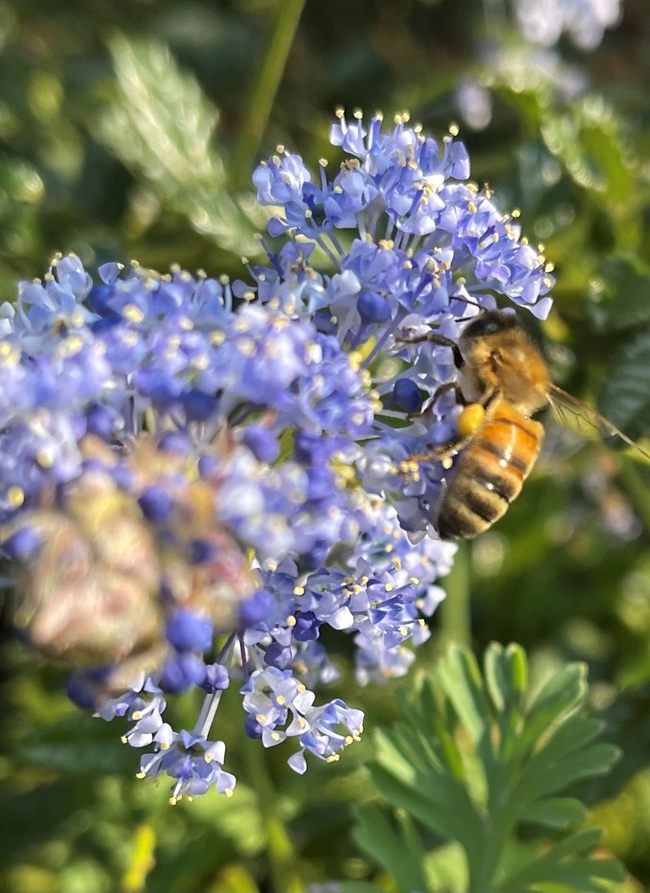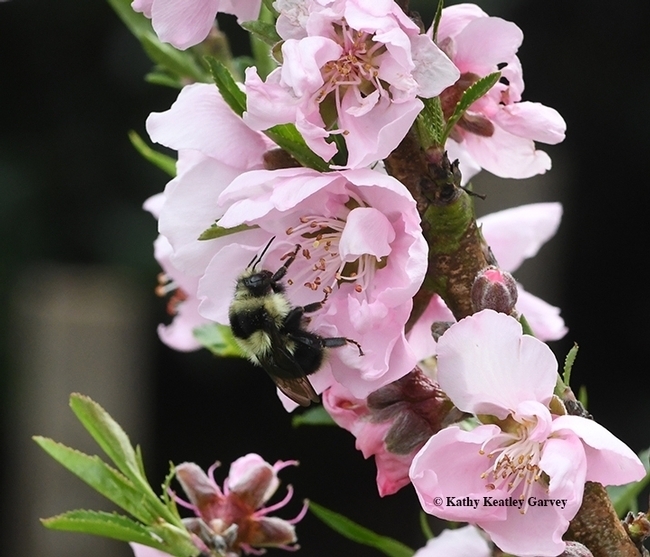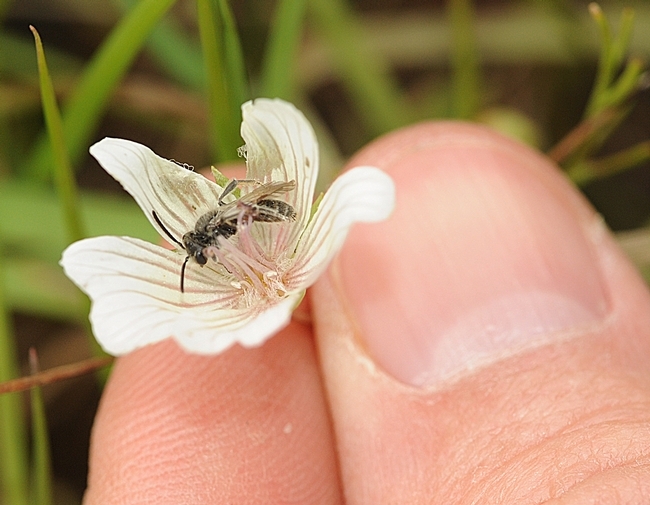- Author: Denise Godbout-Avant

Honey Bees
Honey bees (Apis mellifera) do not hibernate during the winter. During cold days honey bees cluster around their queen to provide her with warmth and feed on their stockpile of nectar. However, when the temperature rises to 55°F (13°C) or higher, worker bees will leave the hive to forage for pollen.
Native Bees: Bumble Bees & Solitary Bees
Unlike honey bees, most bees live underground. Some “early bird” native bee species emerge from their overwintering sites earlier than others. These include black-tip bumble bee (Bombus melanopygus) and yellow-faced bumble bee (Bombus vosnesenskii). Some solitary bees such as mining bees (Adrena) and digger bees (Habropoda) will also appear in the winter.
Plants that Bloom in February
Here, in California's Central Valley, it is not unusual to have some warmer sunny days in the midst of winter. Home gardeners who wish to have gardens that are attractive to bees can provide them with a diversity of plants which bloom during different seasons, including plants that bloom in the winter when flowers can be scarce. By doing this, the gardener ensures there is always a source of pollen for local bees to collect, no matter what time of year it is.

- California Wild Lilac – Ceanothus is an evergreen bush that can turn many Western hills blue in the winter. There are several varieties for home gardeners to choose from including the following:
o Ceanothus griseus horizontalis – Yankee Point ceanothus: A ground cover with light blue flower clusters in winter and spring.
o C. thyrsiflorus – Blueblossom ceanothus: A popular landscaping choice, it varies in height from 2-3 ft. to 25 ft. or more with flowers that range from light to dark blue which bloom in winter and spring.
o C. rigidus ‘Snowball' – White Monterey lilac: As the name suggests, unlike many Ceanothus, this 3-5 ft. tall and wide bush produces white flowers in the fall and winter.
o C.maritimus ‘Valley Violet” – Santa Barbara ceanothus: At 2 ft. tall x 4 ft. wide, this smaller, tough, reliable plant has lovely dark-violet flowers. It was named one of UC Davis Arboretum's 100 top “All-Star” plants.
- Lavandula angustifiola – English lavender: This variety of sweetly fragrant lavender is more tolerant to cold and frost and will bloom throughout the summer and winter if dead blossoms are removed regularly. Ranging from 8 in. to 2ft. width and height, there are many selections to choose from in various shades of lavender-blue, pink or white.
- Manzanita are evergreen bushes native to the far West and need little to moderate water once established. All have small urn-shaped flowers, typically blooming in late winter or early spring followed by red or brown berries that are attractive to birds.
o Arctostaphylos manzanita – Native to California, this bush can get to 7 x 7 ft. with pink flowers.
o A. pajaroennsis – Grows 3-8 ft. tall, 10-12 ft. wide. Pink and white flowers bloom a long time.
- Peritoma arborea – Bladderpod: This drought-tolerate evergreen California native bush, also known as spiderflower, grows 3-6 ft. tall with a 2-3 ft. spread. Showy yellow flowers bloom in late winter through early spring. Easy to grow, they self-seed.
- Cersis occidentalis – Western Redbud: This deciduous tree can grow to 10-18 ft. tall and wide with handsome heart-shaped dark green leaves. Magneta flowers can begin blooming in February in warmer areas.
- Eschscholzia californica – California Golden poppy: California's native flower, some start blooming in the winter and often continue throughout the summer into early autumn. The satiny four-petaled flowers vary from yellow to lighter or darker shades of orange. These 12-inch high plants reseed themselves.
- Hardenbergia violacea - Lilac Vine: Native to Australia, these have twining stems which need support, with evergreen foliage, and clusters of sweet-pea shaped violet, rose or pinkish-purple flowers which provide color to the winter garden. They grow up to 10 ft.
For Valentine's Day Plant a Winter-Blooming Plant
Bees are in decline due to many factors, including pesticide use, urbanization, and Climate Change. When selecting plants for your garden this year, consider placing some winter-blooming, bee-friendly plants in your landscape this Valentine's Day. You'll be providing both native and honey bees with sources of nectar during a time of year when flowers are scarce and adding some color to your winter garden!
If you have flowers blooming right now, we want to hear from you! Please post your favorite February bloomers in the comments below.
Sources and Additional Information:
Sunset Western Garden Book. 2012 Printing
Piedmont Master Gardeners – The Garden Shed Newsletter, August 2019. The Bees In Your Backyard.
https://ucanr.edu/blogs/blogcore/postdetail.cfm?postnum=27237
UCCE Master Gardeners of San Bernadino, May 23, 2018. Getting to Know Our Native Bees.
https://ucanr.edu/blogs/blogcore/postdetail.cfm?postnum=27237
UC Davis Arboretum and Public Garden. Learn More About California Native Bees.
https://arboretum.sf.ucdavis.edu/blog/beyond-honey-bee-learn-more-about-california-native-bees
UC Davis Arboretum and Public Garden. Arboretum All-Stars. https://arboretum.ucdavis.edu/arboretum-all-stars
Xerces Society for Invertebrate Conservation Blog, 27 December 2019.
Insect Apocalypse? What Is Really Happening; Why It Matters; And How We All Can Help.
Denise Godbout-Avant has been a Stanislaus County Master Gardener since 2020.


